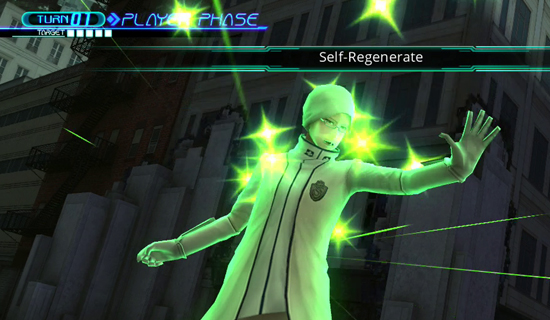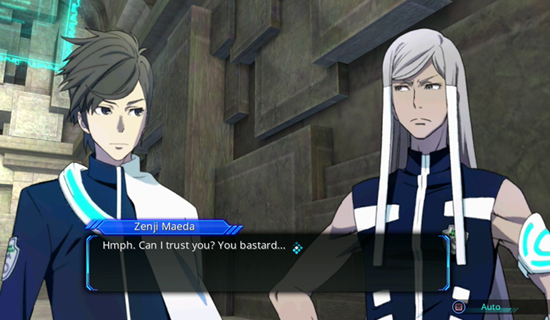Famed Persona developer, Atlus, will from time to time take a niche Japanese game created by a smaller developer and publish it in North America. Several years ago they did this with a little game called Demon’s Souls, and audiences in the west responded by bolstering the game’s sales enough to eventually put it in the PS3’s Greatest Hits library, and since then FromSoftware’s Souls franchise has only continued to grow in popularity. Now Atlus is at it again, taking Lancarse’s strategy RPG titled Lost Dimension and bringing it to North American shores. Has Atlus discovered another hidden Japanese diamond in the rough?
The game’s overlying plot is not complicated: a mysterious being has appeared on earth, unleashing a wave of destruction resulting in the death of billions, and threatening to launch a barrage of nuclear warheads to every corner of the globe in 13 days. The antagonist, who names himself “The End”, erects a giant spire like building, called “The Pillar”, and tells the people of earth that in order to save their planet, someone must ascend The Pillar and defeat him. The United Nations attempts to send in the military, who of course fail spectacularly, leaving the UN only one option: sending in “The Gifted”. You play as Sho Kasugai, a natural born leader and one of very few people who possesses abilities called “Gifts”. After the game’s opening cut scene, Sho wakes up on the base level of The Pillar, he isn’t sure how he got there, but he quickly remembers his goal. Surrounded by 10 similarly gifted individuals, Sho and crew begin their ascent.
Right off the bat its clear the game’s presentation is lacking in originality, from its campy opening cinematic to its extremely generic “guy who wants to destroy the world” plot. Each of the 11 characters in your party seem to fit one stereotype or another, from the stoic ex-military solider and the intellectual medic, to the loner and the overly aggressive rude guy, and of course the main character, Sho, who is the level-headed, well-mannered, natural leader. As the game progresses Sho can pursue dialog options with each party member to delve deeper into their personalities, but each storyline is as predictable as could be. All of the characters use very bland weapons, all of which can be upgraded several times throughout the game, but the upgrades only change your stats, leaving each character to wield the same plain looking pistols and machine guns all game long. Armor upgrades can also be purchased, but again these upgrades don’t provide any visual changes to the character models.
The overall generic feel isn’t only limited to the plot and characters, but also the environments and the enemies who occupy them. The Pillar has five different floors, each of which has its own theme. It’s easy to distinguish one floor from another, based on the color palates alone, but all the levels are covered in boring and uninspired textures. Level design gets more complex as the game progresses, but none of the levels in particular stick out from one another. You’ll face the same arsenal of enemies for the vast majority of the game: the small and weak robotic drones, a variety of humanoid enemies who serve as the mid-tier foe, and the large tank-like enemies who are to be the most feared. The enemies serve their purpose, but do so in the most basic and uninteresting way possible.
While the character’s personalities leave much to be desired, their Gifts make each of them interesting. Each character has a deep tree of different abilities; as they level up they gain Gift Experience, which the player puts into Gifts of their choosing, which in turn opens up more branches in the tree, unlocking more powerful Gifts. Most character’s trees are so large that you will not be able to attain every skill on your first play though, unless you intentionally grind for levels. Each character has their own specialties and defining skills, which makes the player feel as if they are controlling an X-Men like squad of super heroes. While the character’s corny dialog may make you cringe, you will learn to love them for what they bring to the battle field. From Mana’s ability to soak up huge amounts of damage for the party, to Sojiro’s great area-of-effect healing, and Zenji’s ability to link with any of his allies and mimic their Gifts, all 11 members of the team have their uses.
Each mission requires the player to select 5 characters to join Sho in battle. The player will undoubtedly gravitate towards certain characters for a variety of reasons, and become attached to them, which makes the game’s unique twist all that much more interesting. Upon entering The Pillar, The End reveals that there are actually traitors in your group. In order to ascend from one floor of The Pillar to the next, the player must enter the judgment room, where the characters will vote for who they believe is the traitor, which results in the person with the highest votes being permanently killed off. On your first play though, the traitor on the first floor is scripted, in order for the game to explain how the process works, but going forward, on each floor after that, a traitor is randomly selected. This means that a player could potentially devise their entire combat strategy around a certain character or characters (for example: giving Mana all of her Gifts which make her extremely durable, and using her to always lead the way in battle), only to have them turn out to be traitors later on in the game. While this may seem frustrating, it actually adds a great sense of tension, urgency, and mystery to the quest. Losing a character that was core to your team will sting, but it forces you to adapt, look at the other characters more closely, and devise new tactics. Upon reaching the 2nd floor, players are given the tools they need to root out the traitors, thanks to Sho’s Gift of Vision.
Through mixing and matching party members, Sho can eventually narrow the potential traitor down to 3 suspects, and then use a limited resource called “Deep Vision Points” in order to confirm whether or not a person is in fact the traitor. After each successful mission, random party members will ask you who you believe the traitor is, and if the player has strengthened their bond with the person asking them (through exhausting their dialog options), then they’ll be able to sway that characters vote. It doesn’t actually harm you in any way to have a traitor on your team during battle, and it’s not strictly necessary to vote out the traitor if it turns out to be a character you like. You could actually just vote off a character you simply dislike, but be warned: there will be consequences later in the game for players who intentionally (or mistakenly) keep a traitor in their ranks. When a character is sentenced to death, they will reveal whether or not they were a traitor, but the traitor’s reasoning for betraying the group remains a secret until the end of the game. The whole “destruction of the world” plotline takes a back seat to the intrigue and secrecy behind the motive of The End and the traitors, and this mystery, in combination with the game’s solid SRPG game play, should be enough to propel most players to the end of the 25+ hour journey.
For players who are unaccustomed to the strategy-RPG genre, be warned: they’re quite different from your standard role playing game. In Lost Dimension you are either in the Hub area (where you can talk to your team mates, buy gear, use your Gift Points, and do a couple of other things) or you’re doing missions. There is no over world, towns, or talking to random NPCs. The meat and potatoes of SRPGs are the battles. Battles are turn-based, with the player’s team going first, and the enemy team going afterwards. During the players turn each character can move and do one action: a basic attack, using a Gift, using an item, or deferring to another character. Once a character has completed their action, they’re typically done for that turn, unless another character defers to them. Deferring allows a character who’s already had a turn to go again, at the expense of the person deferring to them not being able to attack, or use an item/Gift. This is an extremely interesting mechanic, and could potentially allow your most powerful character to attack 6 times in 1 turn. While the combat may seem pretty basic during the first couple of missions, its depth and complexity becomes rapidly apparent with time.
There are two key mechanics players will need to master if they intend on achieving an S Rank on every mission: assists and Berserk. When a character attacks, if one of their allies is in range, they will provide an assist attack. Proper movement and positioning is paramount. Before moving any of your characters, it’s vital to assess the position of each enemy, and how you can position your squad to maximize the damage from assist attacks. Using any of your characters Gifts, deferring to an ally, or taking damage will lower a character’s sanity meter, and once their sanity hits zero, the character will enter the Berserk state for a couple of turns. When a character goes Berserk their HP bar will refill to its maximum and they’ll do tremendous damage, but they will attack wildly, hitting anything in their range, friend or foe. Sending a low health ally into a group of opponents, using a Gift to force them to go Berserk, and then watching them take down all enemies surrounding them is extremely satisfying.
Players need to keep in mind that the enemy can also capitalize on assist attacks, and enemies will counter attack if they are in range to do so. Each mission can be done a variety of ways depending on your party members, and the preferences and style of the individual playing the game. The intricacy and tactical depth provided in combat might be enough to make you forget the extremely dull enemies and environments, but it isn’t flawless. Often times knee high walls will prevent you from attacking an enemy who is in clear sight, and occasionally enemies who are standing mere inches from you, with no obstructions in-between you at all, will simply be untargetable. For a game that’s already severely lacking in presentation, these game play flaws tarnish the experience.
Lost Dimension is far from a triple A title. It’s rough around the edges, lacks polish, and could use a whole lot more originality. However, despite all its faults, at its core it has some fantastic qualities. The intrigue of having traitorous teammates makes for an interesting emotional attachment to the game’s cast, especially when your favourite member stabs you in the back. Each character has an expansive array of abilities they can learn, and the combat is both deep and tactical. While it doesn’t reach the heights of Final Fantasy Tactics, Tactics Ogre, or Valkyria Chronicals, Lost Dimension is still a good entry in the genre, and a worthy buy for anyone interested in strategy RPGs.
– Matt De Azevedo




